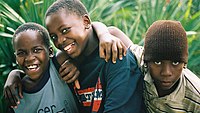
Photo from wikipedia
Abstract Background Despite the high prevalence of bullying among Palestinian refugee students at schools of The United Nations Relief and Work Agency (UNRWA), estimated at 52·5% by Global School-based Students… Click to show full abstract
Abstract Background Despite the high prevalence of bullying among Palestinian refugee students at schools of The United Nations Relief and Work Agency (UNRWA), estimated at 52·5% by Global School-based Students Health Survey done in 2010, little attention is given to it. Compared with worldwide prevalence of bullying, ranging between 7·1% and 70·2%, the prevalence of bullying at UNRWA schools is high. This study aims to understand the determinants behind bullying among Palestinian refugee students at UNRWA to be able to intervene and reduce the prevalence. Methods Qualitative methods for data collection were used. Three focus groups were interviewed at Haifa School in Lebanon among both female and male students of grades 7, 8, and 9 (aged 13–15 years). Every group contained ten students who were asked for both written parental consent and verbal consent. Findings were analysed with thematic analysis. Findings Our findings showed that both individual and environmental factors were determinants of bullying being done among participants. Students' definition of bullying was different from what is accepted in the literature, being defined as physical abuse. Moreover, bullying was not regarded as a harmful behaviour, but instead a way of having fun and seeking a better self-image among their peers. These perceptions were the result of the camp environment. Our findings showed that Palestinian refugee students are exposed to violent acts—eg, hitting and use of guns in the refugee camp—which made them perceive bullying as an acceptable behaviour. Some students stated that they were raised on the idea of holding a gun or a knife to fight and protect themselves. This extreme exposure to violence made participants perceive kicking or hitting for the sake of making fun as being an acceptable behaviour as long as there is no injury. Interpretation The determinants of bullying among Palestinian refugee students are different from those among non-refugee populations as shown in the published literature. Therefore, UNRWA schools should take these differences into consideration when planning future antibullying interventions. Funding The United Nations Relief and Work Agency (UNRWA).
Journal Title: The Lancet
Year Published: 2017
Link to full text (if available)
Share on Social Media: Sign Up to like & get
recommendations!